Evolutionary Ecology
The department of Evolutionary Ecology gathers complementary skills in behavioural ecology, population dynamics, population biology, community ecology, and methodology (statistics and modelling). The research done in the department aims at studying how animal species evolve in a changing world by understanding the causes of the evolution of traits, adaptations and interactions. For that, we consider different levels of organization from individuals to populations and communities. Because organisms cannot be considered isolated from other biotic factors, we consider pathogens but also competing species within communities.
We study how individuals adapt to their environments that are largely impacted by anthropic pressures, and how life history traits and behaviour evolve in response to these pressures. Although we mainly focus on phenotype, we more and more consider the mechanistic link between the genotype and the phenotype. We develop the theoretical framework of our discipline through a conceptual and modeling approach. In parallel, we test hypotheses that arise from theoretical predictions through experimental, comparative and observational approaches on different biological models (insects, birds, mammals). Experimental approaches are developed in the laboratory (insect model) and in natura (bird, insect and mammal models). Observational and comparative research is mainly concerned with vertebrates. Our approaches are also, and increasingly, interested in the mechanisms of adaptive responses. In addition to the classical approaches of demographic analysis and trait change, methods of ecophysiology, chemical ecology and molecular biology are used.
Our department hosts several long-term studies of wild populations of different species. These long-term studies offer a valuable way to understand how biotic and abiotic factors affect individuals’ life history traits, and the functioning of populations in natura. Five populations of mammalian species are thus monitored for several years (more than 40 years on roe deer, 30 on Alpine marmots, 25 years on cats, 16 years on zebras, and 20 years on impala). Two of our study sites (La Sassière in Vanoise National Park (Alpine marmots) and Hwange National Park) have been certified as “Site d’Etude en Ecologie Globale” (SEEG), and two (ZA “Hwange” and ZA “Antarctic and sub-Antarctic”) were certified as “Zone Atelier” by the CNRS.
The department of Evolutionary ecology is also largely involved in training activities. Lastly, we also have strong socio-economic relationships. Indeed, because we address questions of major societal interest (global warming, public health) we tightly collaborate with socio-economic partners (Office Français de la Biodiversité, Vanoise National Park, Hwange National Park in Zimbabwe, Office National des Forêts, etc.) and participate to general public and media events.
Publications
Display of 1 to 30 publications on 2449 in total
Impact of chlordecone pollution on biodiversity: The blind spot of 15 years of public policy in the French West Indies
Peer Community Journal . 5 : e114 [21 p.]
Journal article
see the publicationTrap-dependence in capture–recapture studies: empirical evidence in vertebrates and biological meaning
Oikos .
DOI: 10.1002/oik.11715
Journal article
see the publicationSynching with seasonality: Predicting roe deer parturition phenology across its distributional range
Journal of Animal Ecology .
Journal article
see the publicationCharacterization and diversity of methicillin-resistant Staphylococcus aureus in two hospitals in Gabon
BMC Infectious Diseases . 25 ( 1 ) : 1332
Journal article
see the publicationSex-differences of survival and seasonal dispersal in a meta-population of greater horseshoe bats
Scientific Reports . 15 ( 1 ) : 33345
Journal article
see the publicationEffects of host sex, age and behaviour on co-infection patterns in a wild ungulate.
Parasitology . : 1-15
Journal article
see the publicationEpigenetic Clock Analysis of Sex Chromosome Aneuploidies
Aging Cell .
DOI: 10.1111/acel.70243
Journal article
see the publicationSexual selection drives sex difference in adult life expectancy across mammals and birds
Science Advances . 11 ( 40 )
Journal article
see the publicationLa transmission des agents pathogènes dans le complexe Tiques-Carnivores domestiques : quels enjeux en épidémiologie des maladies vectorielles à tiques et pour la prévention ?
Le Nouveau Praticien Vétérinaire. Canine-Féline . 22 ( 91 ) : 16-23
Journal article
see the publicationCluefish: mining the dark matter of transcriptional data series with over-representation analysis enhanced by aggregated biological prior knowledge
NAR Genomics and Bioinformatics . 7 ( 3 ) : lqaf103
Journal article
see the publicationExploring transcriptomic data with over-representation analysis enhanced by aggregated biological prior knowledge
35th Society of Environmental Toxicology and Chemistry (SETAC 2025) .
Conference paper
see the publicationEnvironmental radioactivity impacts bioenergetic in tree frog of Fukushima
Environmental Pollution . : 127147
Journal article
see the publicationMale Reproductive Senescence in Mammals Is Pervasive and Aligned With the Slow‐Fast Continuum
Ecology Letters . 28 ( 9 )
DOI: 10.1111/ele.70194
Journal article
see the publicationDiversité Taxonomique et Structure des Communautés D'hétéroptères Aquatiques (Heteroptera) Du Bassin Versant De La Medjerda (Tunisie Septentrionale)
Revue de la Faculté des Sciences de Bizerte . 23 : 241-258
Journal article
see the publicationNatal dispersal patterns in a social wild mammal: what does family tell us?
Ecology . 106 ( 9 ) : e70190
DOI: 10.1002/ecy.70190
Journal article
see the publicationComparative life-cycle analyses reveal interacting climatic and biotic drivers of population responses to climate change
PNAS Nexus . : pgaf286
Journal article
see the publicationSpace Use by Crop‐Foraging Barbary Macaques When Crops Are Not Available
Ecology and Evolution . 15 ( 8 ) : e71916
DOI: 10.1002/ece3.71916
Journal article
see the publicationUnderstanding and Predicting Population Response to Anthropogenic Disturbance: Current Approaches and Novel Opportunities
Ecology Letters . 28 ( 8 ) : e70198
DOI: 10.1111/ele.70198
Journal article
see the publicationOffspring number, size, and survival: State‐dependent optimization of litter size in a long‐lived capital breeder
Ecosphere . 16 ( 8 ) : e70370
DOI: 10.1002/ecs2.70370
Journal article
see the publicationWindi App, an R Shiny Tool to Rapidly Assess the Risk of Culicoides Wind Dispersal
13. International Congress for Veterinary Virology Including an EPIZONE Session .
Poster
see the publicationInter-population variation in interspecific social information use is expected: a comment on Slagsvold and Wiebe (2024)
Behavioral Ecology and Sociobiology . 79 ( 8 ) : 82
Journal article
see the publicationClimate warming drives pulsed resources and disease outbreak risk
Proceedings of the Royal Society B: Biological Sciences . 292 ( 2052 )
Journal article
see the publicationEffects of forest structure on the endoparasitism in roe deer Capreolus capreolus
Parasite . 32 : 45
Journal article
see the publicationTrait matching without traits: using correspondence analysis to investigate the latent structure of interaction networks
Peer Community Journal . 5 : e73
Journal article
see the publicationVariation in adult sex ratios in tetrapods is linked to sex chromosomes through mortality differences between males and females
PLoS Biology . 23 : e3003156
Journal article
see the publicationTransposable element expression is associated with sex chromosome number in humans
PLoS Genetics . 21 ( 6 ) : e1011668
Journal article
see the publicationExposure to toxic trace metals is negatively associated with testis mass in wild male roe deer
Environmental Pollution . 383 : 126325
Journal article
see the publicationModelling connectivity at a regional scale during seasonal movements of the greater horseshoe bat
Journal of Applied Ecology .
Journal article
see the publicationNote d'appui scientifique et technique relative aux modalités de surveillance et de lutte contre la brucellose des bouquetins dans les massifs du Bargy et des Aravis
: 19 p.
Report
see the publicationAvis de l’Anses relatif à la « demande d'évaluation du risque de résurgence de la brucellose suite à l'utilisation d'embryons issus du foyer de brucellose bovine en Haute Savoie en 2021»
: 36 p.
Report
see the publication
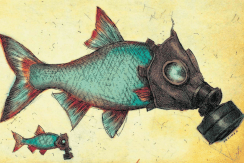
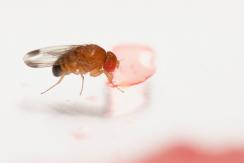
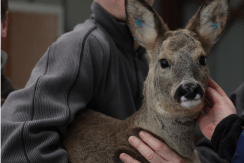
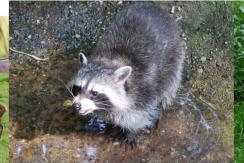
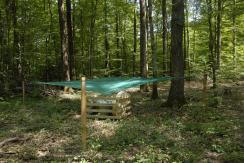
You also, comment on this article